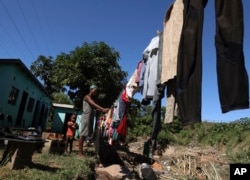Nearly 400 people have died in floods in South Africa's eastern coastal province of KwaZulu-Natal. In the normally bustling city of Durban, survivors are left to begin digging themselves out of the mud and debris.
Ankle-deep in mud, residents of the informal settlement called Mega Village in the south end of Durban have begun the arduous process of cleaning up after devastating floods.
The heavy rains – that saw as much as 300 mm (13 inches) fall within 24-hours at its peak – have been called one of the worst weather events South Africa has ever seen.
Ben Motshwa is among the countless residents of Mega Village who saw their homes, made of corrugated iron, wash away in the blink of an eye Monday.
“When the flood was coming, we only had to run,” he said. “There was nothing we could do. And if we’re running, where are we running to? We didn’t have anywhere to go to. Just moving. Just going to where we think there is some sort of dry area where we can maybe stand. We lost basically everything.”
Motshwa said his small printing business was also washed away, leaving him with no source of income.
The community, built on a flood plain, is a symptom of the country’s preexisting housing crisis, now under even greater pressure.
The government estimates that over 13,500 homes were damaged by the floods, of which nearly 4,000 were destroyed.
Many people have sought temporary shelters.
Mlungisi Thabethe and his wife were among dozens of people who registered for shelter, sleeping on the hard floor of a community hall in an apartment block by Mega Village.
“We came here because we have no house, no nothing now,” he said. “Me, I’ve got only my bag here and my umbrella. And I got a chance to take my jacket. And then that’s all I have now, nothing else. I’m lose everything. Even my trust now. I lose my hope too. I don’t know what I’m going to do.”
Even residents who didn’t lose their homes were battered by the destruction.
Both electricity and water to Mega Village was out for nearly a week.
Appliances were broken, furniture and belongings were drenched and damaged.
The government has pledged to deliver aid to everyone affected, but for residents battling to clear out the debris, help wasn’t coming fast enough.
Tutu Hlophe, a sangoma or traditional healer in Mega Village, started his cleanup, hand-washing the mud off his clothes and linens, along with his neighbors.
He said it wasn’t the first time the area was flooded — although it was the worst — and he doesn’t trust the ruling African National Congress to deliver aid.
“This government of ANC can’t help us,” he said. Ten years now staying in this area, everything is not okay.”
He added that change is needed because people are just suffering and need the government’s help.
Officials from the regional government visited the community Friday to assess the damage and prioritize what necessities need to be delivered.
Cosmos Khanyeza, a community leader in Umlazi, who was helping set up temporary shelters for flood victims and collect aid, said officials promised to bring foam mattresses and blankets for the homeless Saturday.
“People they are sleeping down, down on the floor on this cold weather,” he said. “And people are scared to go back to their shacks or to build another shack in that place because they said they don’t (want to) become the victims again if the floods happen again.”
Those in shelters may be staying dry, but low-lying communities have found themselves at risk again.
The South African Weather Service warned heavy rains that returned Saturday could cause repeated flooding and mudslides, further damaging homes and infrastructure.







